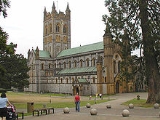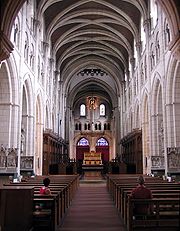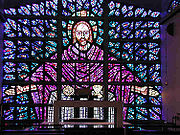
Buckfast Abbey
Encyclopedia
Buckfast Abbey forms part of an active Benedictine
monastery at Buckfast, near Buckfastleigh
, Devon
, England. Dedicated to Saint Mary, it was founded in 1018 and run by the Cistercian order from 1147 until it was destroyed under the Dissolution of the Monasteries
. In 1882 monks began living there again, and today it is a Benedictine foundation.
in 1018. In 1147 it became a Cistercian abbey and was rebuilt in stone. In medieval times, the abbey became rich through fishing and trading in sheep wool, although the Black Death
killed two abbots and many monks — by 1377 there were only fourteen monks at Buckfast.
On 25 February 1539, William Petre
arrived at Buckfast and declared the abbey to be dissolved by order of King Henry VIII
. The monks were compelled to leave and the buildings were looted and destroyed. The abbey then stood in ruins for over two hundred years.
and it was later bought for £4,700. The first new abbot was Boniface Natter, who died in a shipwreck in 1906. His travelling companion Anscar Vonier became the next abbot and pledged to fulfil his dying wish, namely to rebuild the abbey.
The monks lived among the ruins and gradually rebuilt the abbey church upon the foundations of the abbey constructed in 1147. The church itself was restored between 1905 and 1937. Over the thirty two years, there were never more than six monks working on the project at any one time, although the whole community had repaired the ancient foundations up to ground level. Construction methods were primitive — wooden scaffolding was held together by ropes and no safety protection was worn by the monks. One monk fell 50 feet but survived and three monks fell off a hoist without serious injury in 1931. Construction continued through World War I
, with the German monks being unable under local law to leave the abbey grounds.
The Abbey was consecrated on 25 August 1932, but the building was finally finished with the laying of the last stone in late 1937.


 The Abbey is self-supporting, with a farm where vegetables are grown and bees, pigs and cattle are kept, a shop which sells wine, honey beeswax, fudge and other items made by religious communities throughout the world, and a gift shop, book shop, and restaurant.
The Abbey is self-supporting, with a farm where vegetables are grown and bees, pigs and cattle are kept, a shop which sells wine, honey beeswax, fudge and other items made by religious communities throughout the world, and a gift shop, book shop, and restaurant.
, a strong tonic wine which the monks began making (to a French recipe) in the 1890s. The strength of "Buckfast", and its misuse, have been a controversial issue for the abbey.
in 1898 in Germany, died in 1996) was put in charge of the Abbey's beekeeping
in 1919, and began extensive breeding work creating the honeybee known as the Buckfast bee
. Brother Adam had to replenish the bee colonies as 30 of the monastery's 46 colonies had been wiped out by a disease called "acarine", all the bees that died were of the native British black bee. The remaining 16 hives that survived were of Italian origin.
for boys aged 7 to 13. Two former monks were later convicted and imprisoned for sexually abusing
boys during this period.
, Plymouth
-based St Boniface's Catholic College evacuated its pupils to Buckfast Abbey between 1941-1945. The school later named one of its Houses "Abbey" in memory of this period in their history.
Cistercian abbots
Benedictine abbots:
Benedictine
Benedictine refers to the spirituality and consecrated life in accordance with the Rule of St Benedict, written by Benedict of Nursia in the sixth century for the cenobitic communities he founded in central Italy. The most notable of these is Monte Cassino, the first monastery founded by Benedict...
monastery at Buckfast, near Buckfastleigh
Buckfastleigh
Buckfastleigh is a small market town and civil parish in Devon, England situated beside the Devon Expressway at the edge of the Dartmoor National Park. It is part of Teignbridge District and, for ecclesiastical purposes lies within the Totnes Deanery. It has a population of 3,661...
, Devon
Devon
Devon is a large county in southwestern England. The county is sometimes referred to as Devonshire, although the term is rarely used inside the county itself as the county has never been officially "shired", it often indicates a traditional or historical context.The county shares borders with...
, England. Dedicated to Saint Mary, it was founded in 1018 and run by the Cistercian order from 1147 until it was destroyed under the Dissolution of the Monasteries
Dissolution of the Monasteries
The Dissolution of the Monasteries, sometimes referred to as the Suppression of the Monasteries, was the set of administrative and legal processes between 1536 and 1541 by which Henry VIII disbanded monasteries, priories, convents and friaries in England, Wales and Ireland; appropriated their...
. In 1882 monks began living there again, and today it is a Benedictine foundation.
History
Buckfast Abbey was founded by Earl Aylward in the reign of King CnutCanute the Great
Cnut the Great , also known as Canute, was a king of Denmark, England, Norway and parts of Sweden. Though after the death of his heirs within a decade of his own and the Norman conquest of England in 1066, his legacy was largely lost to history, historian Norman F...
in 1018. In 1147 it became a Cistercian abbey and was rebuilt in stone. In medieval times, the abbey became rich through fishing and trading in sheep wool, although the Black Death
Black Death
The Black Death was one of the most devastating pandemics in human history, peaking in Europe between 1348 and 1350. Of several competing theories, the dominant explanation for the Black Death is the plague theory, which attributes the outbreak to the bacterium Yersinia pestis. Thought to have...
killed two abbots and many monks — by 1377 there were only fourteen monks at Buckfast.
On 25 February 1539, William Petre
William Petre
Sir William Petre was a secretary of state to Henry VIII, Edward VI, Mary I and Elizabeth I.Educated as a lawyer at Oxford, he became a public servant, probably through the influence of the Boleyns, one of whom, George, he had tutored at Oxford and another of whom, Anne, was married to the king...
arrived at Buckfast and declared the abbey to be dissolved by order of King Henry VIII
Henry VIII of England
Henry VIII was King of England from 21 April 1509 until his death. He was Lord, and later King, of Ireland, as well as continuing the nominal claim by the English monarchs to the Kingdom of France...
. The monks were compelled to leave and the buildings were looted and destroyed. The abbey then stood in ruins for over two hundred years.
19th century: rebuilding
On 28 October 1882, six Benedictine monks arrived at Buckfast having been exiled from France. The land had been leased by monks from the St. Augustine's Priory in RamsgateRamsgate
Ramsgate is a seaside town in the district of Thanet in east Kent, England. It was one of the great English seaside towns of the 19th century and is a member of the ancient confederation of Cinque Ports. It has a population of around 40,000. Ramsgate's main attraction is its coastline and its main...
and it was later bought for £4,700. The first new abbot was Boniface Natter, who died in a shipwreck in 1906. His travelling companion Anscar Vonier became the next abbot and pledged to fulfil his dying wish, namely to rebuild the abbey.
The monks lived among the ruins and gradually rebuilt the abbey church upon the foundations of the abbey constructed in 1147. The church itself was restored between 1905 and 1937. Over the thirty two years, there were never more than six monks working on the project at any one time, although the whole community had repaired the ancient foundations up to ground level. Construction methods were primitive — wooden scaffolding was held together by ropes and no safety protection was worn by the monks. One monk fell 50 feet but survived and three monks fell off a hoist without serious injury in 1931. Construction continued through World War I
World War I
World War I , which was predominantly called the World War or the Great War from its occurrence until 1939, and the First World War or World War I thereafter, was a major war centred in Europe that began on 28 July 1914 and lasted until 11 November 1918...
, with the German monks being unable under local law to leave the abbey grounds.
The Abbey was consecrated on 25 August 1932, but the building was finally finished with the laying of the last stone in late 1937.
The grounds
There is a conference and seminar centre, and a restaurant (the Grange). On the west side of the Abbey are two gardens with plants ranging from herbs used in cooking or medicine to poisonous plants. Behind the public area is an enclosed garden for the monks. A bridge leads over the river to the abbey farm.Self sufficiency



Buckfast Tonic Wine
The monastery's most successful product is Buckfast Tonic WineBuckfast Tonic Wine
Buckfast Tonic Wine, commonly known as Buckfast or Buckie or Tonic , is a fortified wine licensed by Buckfast Abbey in Devon, south west England. It is distributed by J...
, a strong tonic wine which the monks began making (to a French recipe) in the 1890s. The strength of "Buckfast", and its misuse, have been a controversial issue for the abbey.
Beekeeping
Brother Adam (born Karl KehrleKarl Kehrle
Karl Kehrle was a Benedictine monk, beekeeper, and an authority on bee breeding, developer of the Buckfast bee. "He was unsurpassed as a breeder of bees. He talked to them, he stroked them...
in 1898 in Germany, died in 1996) was put in charge of the Abbey's beekeeping
Beekeeping
Beekeeping is the maintenance of honey bee colonies, commonly in hives, by humans. A beekeeper keeps bees in order to collect honey and other products of the hive , to pollinate crops, or to produce bees for sale to other beekeepers...
in 1919, and began extensive breeding work creating the honeybee known as the Buckfast bee
Buckfast bee
The Buckfast bee is a honey bee a cross of many species of bees into a stable race developed by "Brother Adam", , who was in charge of beekeeping at Buckfast Abbey, where the bees are still bred today.-Origin:...
. Brother Adam had to replenish the bee colonies as 30 of the monastery's 46 colonies had been wiped out by a disease called "acarine", all the bees that died were of the native British black bee. The remaining 16 hives that survived were of Italian origin.
Buckfast Abbey Preparatory School
From 1967 until 1994, the abbey ran a prep schoolPreparatory school (UK)
In English language usage in the former British Empire, the present-day Commonwealth, a preparatory school is an independent school preparing children up to the age of eleven or thirteen for entry into fee-paying, secondary independent schools, some of which are known as public schools...
for boys aged 7 to 13. Two former monks were later convicted and imprisoned for sexually abusing
Sexual abuse scandal in the English Benedictine Congregation
The sexual abuse scandal in the English Benedictine Congregation is a significant episode in the series of Catholic sex abuse cases in the United Kingdom.-Ealing Abbey:...
boys during this period.
St Boniface's Catholic College
With the outbreak of World War IIWorld War II
World War II, or the Second World War , was a global conflict lasting from 1939 to 1945, involving most of the world's nations—including all of the great powers—eventually forming two opposing military alliances: the Allies and the Axis...
, Plymouth
Plymouth
Plymouth is a city and unitary authority area on the coast of Devon, England, about south-west of London. It is built between the mouths of the rivers Plym to the east and Tamar to the west, where they join Plymouth Sound...
-based St Boniface's Catholic College evacuated its pupils to Buckfast Abbey between 1941-1945. The school later named one of its Houses "Abbey" in memory of this period in their history.
Abbots
Benedictine abbots:- Alwin (Aelwinus) first mentioned as having attended Shire-mote in Exeter in about 1040. Known from the Domesday BookDomesday BookDomesday Book , now held at The National Archives, Kew, Richmond upon Thames in South West London, is the record of the great survey of much of England and parts of Wales completed in 1086...
to have been Abbot in 1066. - Eustace first mentioned in 1143 in a Totnes Deed. He was Abbot when Buckfast was affiliated to the Abbey of Citeaux (Cistercian).
Cistercian abbots
- Buckfast still followed the Rule of St. Benedict, as the Cistercians also live by that Rule.
- William acted as Papal Legate in 1190.
- Nicholas elected in 1205.
- Michael mentioned in the Cartulary of Buckfast Abbey (C.B.A.) in 1223.
- Peter (I) mentioned in the C.B.A. 1242.
- William (II) mentioned in the C.B.A. 1249.
- Howell mentioned in the Leger Book (L.B.) of Buckfast (Brit. Mus.) - no dates.
- Henry mentioned in C.B.A. 1264 and 1269.
- Simon mentioned in C.B.A. and Petre Archives (P.A.) between 1273 and 1280.
- Robert mentioned in L.B. and Exeter Episcopal Registers (Ep. Reg.) between 1280 and 1283.
- Peter de Colepitte mentioned in the P.A. between 1291 and 1313
- Robert II mentioned in the Ep. Reg. 1316.
- William Atte Slade mentioned in the Banco Rolls 1327.
- Stephen I mentioned in the Ep. Reg. 1328.
- John of Churchstowe mentioned in the Ep. Reg. 1332.
- William Gifford mentioned in the Ep. Reg. 1333.
- Stephen of Cornwall mentioned in the Ep. Reg. 1348.
- Philip (Beaumont) mentioned in the Ep. Reg. 1349.
- Robert Symons mentioned in the Ep. Reg. and P.A. between 1355 and 1390.
- William Paderstow mentioned in the Ep. Reg and P.A. 1395.
- William Slade mentioned in the Ep. Reg. and by Leland - "Com. de Scriptoribus Britanniae" and Boase - "Annals of Exeter College, Oxford" between 1401 and 1415.
- William Beaghe mentioned in the Ep. Reg. and P.A. between 1415 and 1432.
- Thomas Roger mentioned in Ep. Reg. and P.A. He was Prior Administrator c. 1422 - 1432, and blessed as Abbot in 1432.
- John Ffytchett mentioned in the Ep. Reg. 1440.
- John Matthu (Matthew) mentioned in the Ep. Reg. 1449.
- John King mentioned in the Statuta Cap. Gen. Ord. Cist. from 1464 to 1498.
- John Rede (I) mentioned in the Ep. Reg. 1498.
- John Bleworthy mentioned in 1505 - Cal. of Early Chancery Proceedings, also in Powderham MSS.
- Alfred Gyll mentioned in the Ep. Reg. 1512.
- John Rede (II) mentioned in the Ep. Reg. 1525. There is no record of death or resignation from his office.
- Gabriel Dunne (or Donne) imposed on the Community in 1535 by Thomas Cromwell. He surrendered the Abbey to the king on 25 February 1539.
Benedictine abbots:
- Monastic life was restored at Buckfast in 1882.
- Thomas Duperou - Superior: 1882 till 1884 (became Abbot of Sacred Heart, USA)
- Leander Lemoine - Superior: 1884 till 1885
- Benedict Gariador - Prior: August 1885, till February 1899
- Leander Lemoine - Superior: March 1899
- Ignatius Jean - Superior: April 1899, till March 1900 (not a Monk of Buckfast)
- Leander Lemoine - Superior: March 1900 to July 1902 (was also Abbot Visitor)
- Savinian Louismet - Superior: July 1902 to November 1902
- Boniface Natter elected 19 November 1902. Died 4 August 1906.
- Anscar Vonier elected 14 September 1906. Died 26 December 1938.
- Bruno Fehrenbacher elected 10 January 1939. Resigned 1956. Titular Abbot of Tavistock till his death on 18 July 1965.
- Placid Hooper elected 5 January 1957. Ruling Abbot till 1976. Titular Abbot of Tavistock till his death on 11 December 1995
- Leo Smith elected 30 January 1976. Ruling Abbot till 1992. Titular Abbot of Colchester till his death on 10 July 1998
- David Charlesworth elected 3 January 1992. Ruling Abbot till 1999. Titular Abbot of Malmesbury.
- Sebastian Wolff appointed Prior Administrator in January 2000
- Philip Manahan elected Abbot 10 December 2003. Resigned December 2006. Sentenced to 15 months in prison for child sex abuse in November 2007.
- Richard Yeo appointed Abbot Administrator February 2007 until January 2009
- David Charlesworth elected 27 January 2009

